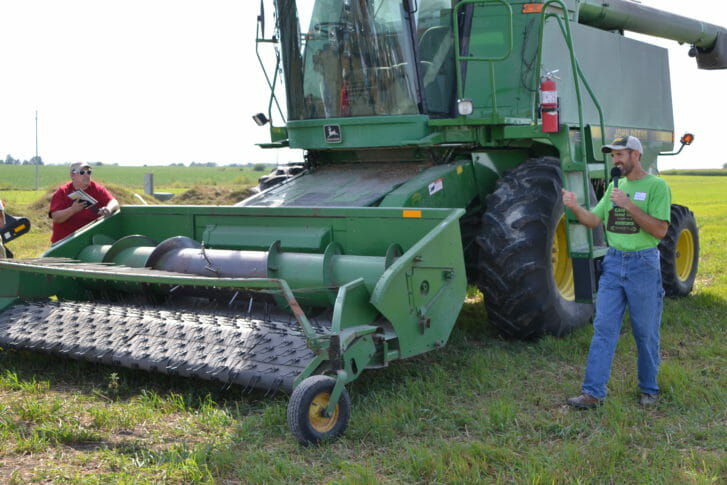Small Grains Harvest: Maintaining Quality With the Equipment You Have
Small grains harvest is already underway in parts of Iowa and beyond, and some fields are still weeks away from being ready. On July 6 Earl Canfield hosted our small grains conference call. Earl shared ways to maintain the quality of small grains while harvesting. He discussed his specialized equipment and swathing technique for oats for his on-farm animal feed business. And, he also talked about ways to manage post-harvest handling and storage in order to maintain grain quality.
Many farmers on the call were a few weeks away from harvest. Some plan to either swath or direct cut their oats and rye. A few people plan to do a combination of both to manage weeds. Earl and his wife Jane farm in northeast Iowa near Dunkerton. They got back into raising small grains four years ago when their kids got back into farming. This year they have about 50 acres of small grains planted. Earl said he’s learned a lot of things the hard way with raising and harvesting small grains.
Choosing Harvesting Equipment:
In 2015 Earl harvested part of his small grains using direct cutting, and the other part with a self-propelled swather on 10 acres. Then, it wasn’t the best machine, but he liked what it did to the oats in terms of making it more harvestable for the combine. Earl only used that swather for a year then found another multipoint swather to harvest oats in 2016. PFI member Clark Porter in Reinbeck went in on the deal with him to share the equipment cost. Earl said, “It worked like a dream compared to that [self-propelled swather]”. He had tried using both pieces of equipment and ran into issues because the oat files are fairly clean but, depending on when he cut his oats, it was really challenging because of the weeds going under the oat canopy.
How you harvest affects how the crop feeds into the auger platform. Earl said that you have to have a good flow to have it feed into the machine. He’s gotten away from straight cutting and now swathes to pick up the combine head. Swathing allows him to cut green material while plugging up the machine less. It also allows him to grab more oats in the field. Earl said, “Our multi-swather helps us recover oats that are down.” This year even though they’ve had some pretty strong winds, there are only a few acres out of the 50 down.
Earl uses a 12 ft. pickup head on the 20 ft. combine machine. It’s a little more to manage with gas, but he’s had good grain quality with this process. It gives him consistency and more options though. If you want to do straw for example, you can do that right behind the combine. For Earl, harvesting his oats usually comes in late July or early August when the weather seems to be dry enough.

Canfield combine with pickup head
Harvest timing affects how well swathing goes and can be a good indicator of the quality of your crop. If you can get in and swath before they’re dry, Earl said the heads need to be mature. When you drop the heads while still attached to the stalk, they can go through the sweating process.
Storage:
Depending on the way you harvest, bin aeration allows you to have more options for the crop to sweat in a stable and quality manner. Earl has one bin with aeration in it, which helps blow the chaff off of the oats. He said it gives you another round of cleaning for using or selling oats. He has other bins with tube-type aeration which helps manage the sweating process. If you manage the temperature and keep the oats dry, they’ll keep a long time.
Questions for Earl:
Does the moisture content drop in the bin once you have the fan on?
I harvest my oats in early August when most of the sweating happened early in the field. I wait until the weather gets good and cold, then blow some fresh air on them once in a while.
How do you do your windrow?
I leave 6-8 inches of stubble. The windrow blew down areas of the field, but that couple of inches helped us recover.
Do you use interseeding?
Three years ago we had a mix of alfalfa and grass, which determines how high or how low you swath. I swathed the first part of the field, then direct cut the second. The auger platform couldn’t handle all of green material. The air reel at the time didn’t cut too much green material off, so we didn’t have to. Give the machine time to work. Now we have oats with clover out there, it’s not exploding with growth, there should be more by the time oats are ready to lay down.
Earl ended the call with some insight about his learning process, “Everybody has to figure out what will work best for their situation. You have to understand the pros and cons of each and manage that system appropriately.”
Disease testing:
For folks interested in identifying oat or leaf and stem diseases, Bruce Roskens of Grain Millers, Inc. asked call participants to send leaf or whole plant samples to: Cereal Disease Laboratory, 1551 Lindig Street, University of Minnesota, St. Paul Minnesota 55108. Please address to “Attention: Yue Jin (stem rust) or Roger Caspers (leaf rust)” and send a note with your name, address, county, variety name, date sample taken, and stage of plant growth. If you want information regarding the disease returned, make certain to request info back.
If you’d like to get in touch with Earl Canfield, please contact him at canfieldfarms@dunkerton.net or (319) 269-0739.

